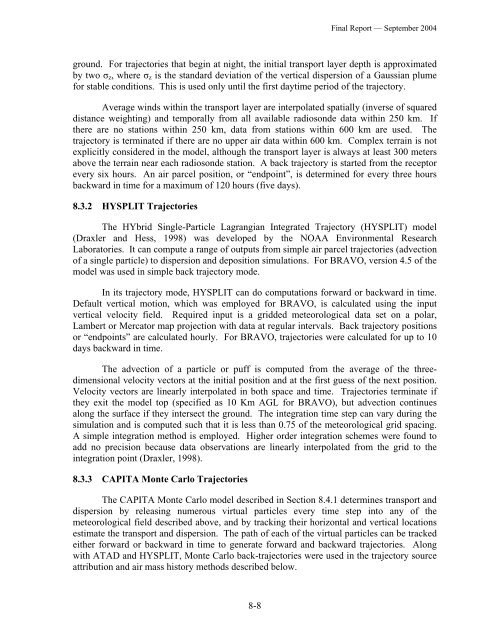(BRAVO) Study: Final Report. - Desert Research Institute
(BRAVO) Study: Final Report. - Desert Research Institute
(BRAVO) Study: Final Report. - Desert Research Institute
You also want an ePaper? Increase the reach of your titles
YUMPU automatically turns print PDFs into web optimized ePapers that Google loves.
<strong>Final</strong> <strong>Report</strong> — September 2004<br />
ground. For trajectories that begin at night, the initial transport layer depth is approximated<br />
by two σ z , where σ z is the standard deviation of the vertical dispersion of a Gaussian plume<br />
for stable conditions. This is used only until the first daytime period of the trajectory.<br />
Average winds within the transport layer are interpolated spatially (inverse of squared<br />
distance weighting) and temporally from all available radiosonde data within 250 km. If<br />
there are no stations within 250 km, data from stations within 600 km are used. The<br />
trajectory is terminated if there are no upper air data within 600 km. Complex terrain is not<br />
explicitly considered in the model, although the transport layer is always at least 300 meters<br />
above the terrain near each radiosonde station. A back trajectory is started from the receptor<br />
every six hours. An air parcel position, or “endpoint”, is determined for every three hours<br />
backward in time for a maximum of 120 hours (five days).<br />
8.3.2 HYSPLIT Trajectories<br />
The HYbrid Single-Particle Lagrangian Integrated Trajectory (HYSPLIT) model<br />
(Draxler and Hess, 1998) was developed by the NOAA Environmental <strong>Research</strong><br />
Laboratories. It can compute a range of outputs from simple air parcel trajectories (advection<br />
of a single particle) to dispersion and deposition simulations. For <strong>BRAVO</strong>, version 4.5 of the<br />
model was used in simple back trajectory mode.<br />
In its trajectory mode, HYSPLIT can do computations forward or backward in time.<br />
Default vertical motion, which was employed for <strong>BRAVO</strong>, is calculated using the input<br />
vertical velocity field. Required input is a gridded meteorological data set on a polar,<br />
Lambert or Mercator map projection with data at regular intervals. Back trajectory positions<br />
or “endpoints” are calculated hourly. For <strong>BRAVO</strong>, trajectories were calculated for up to 10<br />
days backward in time.<br />
The advection of a particle or puff is computed from the average of the threedimensional<br />
velocity vectors at the initial position and at the first guess of the next position.<br />
Velocity vectors are linearly interpolated in both space and time. Trajectories terminate if<br />
they exit the model top (specified as 10 Km AGL for <strong>BRAVO</strong>), but advection continues<br />
along the surface if they intersect the ground. The integration time step can vary during the<br />
simulation and is computed such that it is less than 0.75 of the meteorological grid spacing.<br />
A simple integration method is employed. Higher order integration schemes were found to<br />
add no precision because data observations are linearly interpolated from the grid to the<br />
integration point (Draxler, 1998).<br />
8.3.3 CAPITA Monte Carlo Trajectories<br />
The CAPITA Monte Carlo model described in Section 8.4.1 determines transport and<br />
dispersion by releasing numerous virtual particles every time step into any of the<br />
meteorological field described above, and by tracking their horizontal and vertical locations<br />
estimate the transport and dispersion. The path of each of the virtual particles can be tracked<br />
either forward or backward in time to generate forward and backward trajectories. Along<br />
with ATAD and HYSPLIT, Monte Carlo back-trajectories were used in the trajectory source<br />
attribution and air mass history methods described below.<br />
8-8
















